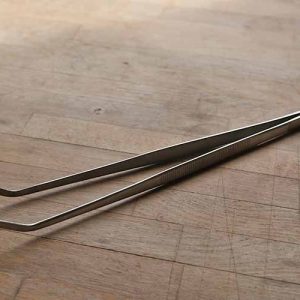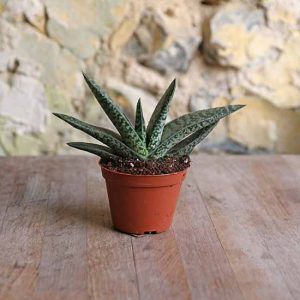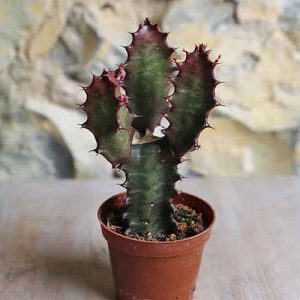HOW TO CARE FOR YOUR EUPHORBIA TRIGONA (AFRICAN MILK TREE)
THE AFRICAN MILK TREE
Euphorbia trigona AKA. Cathedral Cactus / Abyssinian Euphorbia / High Chaparall / Candelabra Cactus / Friendship Cactus / Good Luck Plant
This spiky beauty might look like a cactus but it is actually a species of succulent. Distinguished by its impressive upright stems and unusual combination of thorny spines and podgy leaves, this African succulent is a real showstopper. The stems of this towering plant are marked by pretty V-shaped patterns of dark and light green and the plant’s distinctive drop-shaped leaves sprout from the gaps between the spines along the stalk.
Where Does It Come From?
Originating from the countries of Central Africa, this tall perennial can withstand considerable droughts and enjoys heat. It is often used as a hedge in Central African nations due to its enthusiastic growth and its use has been noted during community rituals in countries such as Gabon.
Why Should I Get One?
- The plant is known for its rapid growth and non-invasive roots, making it an extremely satisfying houseplant to grow if you’re one who likes to see quick progress. With perfect conditions, you can expect to see up to two-feet of growth per year.
- African Milk Trees are not over fussy when it comes to soil type. They prefer a sandy pot but can tolerate other compositions extremely well, meaning that it makes a lovely addition to a mixed succulent garden. Good drainage is essential though.
- This plant is perfect for adding a little decorative drama to a room and is very easy to propagate. You simply have to break off an ‘arm’ with a little root material and plant it in some suitable soil.
How Big Can It Grow?
Grown in ideal conditions, these plants can reach a staggering 3-metres tall but it is rarely allowed to reach such a height. A common problem facing such trigonas is that their shallow root system leads to structural instability, meaning that once the plant grows to a certain height, it can be at risk of falling over and making a mess!
Where Should I Keep It?
In general the African Milk Tree likes indirect but bright sunlight so a southern-facing window will work well for it indoors. Outdoors, a sheltered spot with partial sun will give you the best hope of growing a good specimen. Full sun is acceptable to the plant as long as you offset the extra brightness with a little more watering. This drought-tolerant little guy enjoys a dry climate in the wild, and can tolerate fairly hot temperatures. Conversely, it hates the cold. Unlike plants that grow in sweaty tropical conditions, these plants do not expect high humidity and an over-humid atmosphere can increase the risk of fungus and pests. The plant should be kept well out of the reach of small children and pets as all parts of the plant are toxic if ingested.
TOP TIP: As with many other species of euphorbia, the latex from the plant is poisonous and can cause nasty skin irritations. When manhandling or moving the plant, it is best to wear gloves to avoid the milky white sap that gives the plant its name irritating your skin.
How Often Should I Water It?
Being a succulent, and one from Central Africa at that, this plant doesn’t get too thirsty too often. Your plant should be watered moderately just once a week. Make sure to allow the soil dry out between waterings, to mimic its natural habitat and avoid root-rot.
Tolerant, striking and very exotic, these spiky succulents are the perfect feature piece for your room. Relatively easy to care for and super low-maintenance, the rewards for growing one of these beautiful plants can be enormous.
-
Quick View
 Sold OutSelect options This product has multiple variants. The options may be chosen on the product page quick view
Sold OutSelect options This product has multiple variants. The options may be chosen on the product page quick view -
Quick View
-
Quick View
Mini Ox Tongue Succulent (Gasteria Carinata)
Baby House Plants, Cacti + Succulents, Mini Terrarium Plants, View All £5.80 -
Quick View
Small African Milk Tree (Euphorbia Trigona Rubra)
Baby House Plants, Cacti + Succulents, Mini Terrarium Plants, View All £6.20



